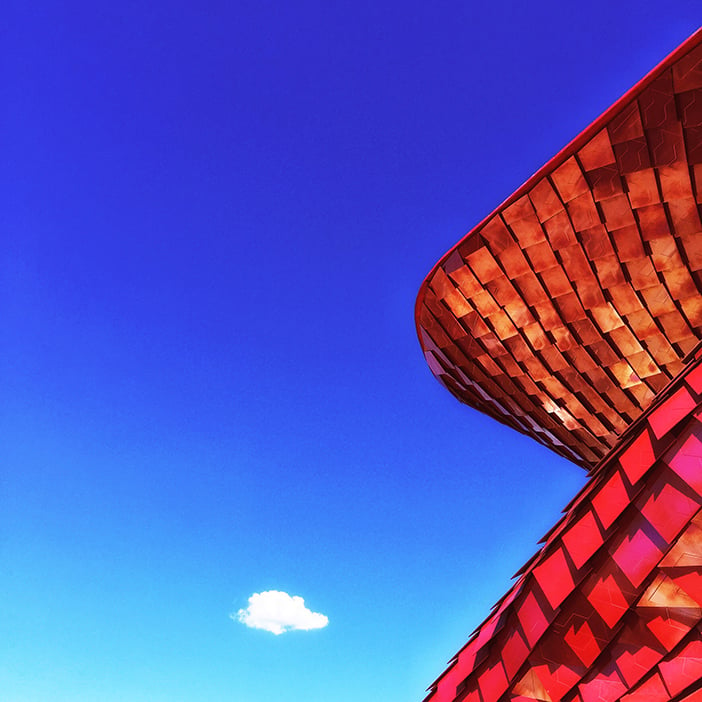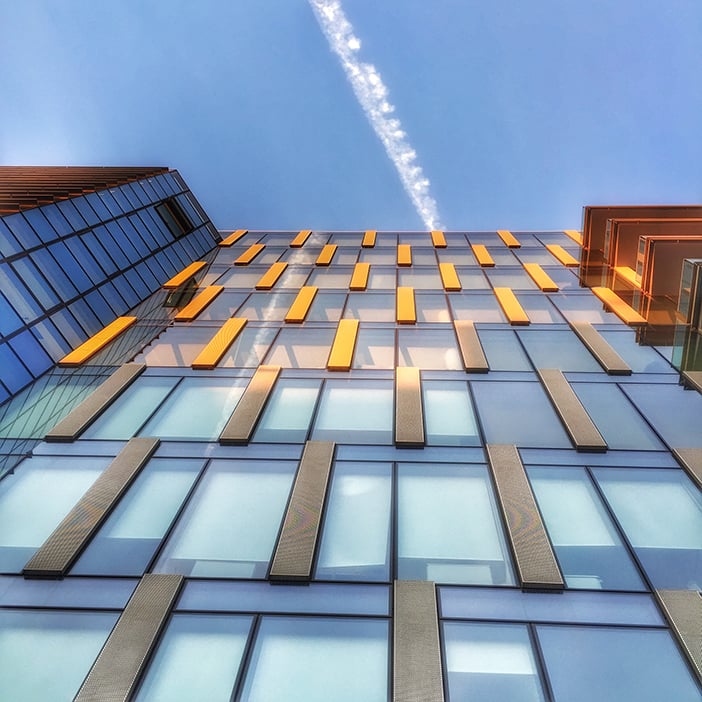By day Tomaso Belloni is an astrophysicist at the Italian National Institute for Astrophysics (INAF) but when not looking for signs of black holes he can be found behind the lens of his trusty iPhone. Tomaso is a prolific iPhone photographer who is carving out a distinctive style that often features tightly cropped street scenes, snippets of contemporary architecture and reflections all conveyed in a vibrant and colorful way with a hint of texture thrown in. His work has been featured numerous times on Mobiography as well as other iPhoneography websites and has gained him recognition in the Mobile Photography Awards.
I caught up with Tomaso to find out a bit more about his approach to his photography, composition and what inspires him to take photos with his iPhone.
Firstly, could you tell us a bit about yourself?
I live in northern Italy, near Milan where I was born. I am an astrophysicist at the Italian National Institute for Astrophysics (INAF) and work on observations of black holes. I lived abroad for more than a decade and still travel extensively for work reasons, which allows me to visit several distant places every year. My interest in photography came with the iPhone and is now occupying most of my free time. I grew up with both parents being architects: art and design was always in the air and impossible not to absorb, although my interest was into science since when I was very young. Unfortunately, my drawing skills are very poor, although I was able to produce decent abstract colourful compositions, which came back to me with photography. My work has not been featured in an exhibition. A number of my photos have been included in online showcases by Mobiography, AppWhisperer, iPhoneography Central and others. One photo [photo1] has received an honorable mention in the 2014 MPA awards and one just today in the 2015 ones, in the same category “Architecture and Design,” which would have made my late father, who was an architect, very proud.
How were you first introduced to iPhone photography?
It all happened by chance in March 2013, when during a three-month stay in England. I took a shot of a collapsed building with my iPhone4 and discovered I had a couple of apps to edit it. I searched the web and discovered a whole world of other apps, which prompted me to take more photos with the iPhone and edit them on an iPad (the phone is often too small for me). From there I went on absorbing as much as I could about composition and photographic techniques, as well as learning from a number of good artists from online resources, including of course Mobiography. The initial excitement was about the editing possibilities, which I used rather excessively. With time, I reduced the amount of post processing and concentrated more on composition. I was not into photography back then, but the possibilities offered by that camera, both in terms of portability and editing, captured me almost immediately. It has of course several limitations, but limitations boost creativity.
I now also do “conventional” photography with a mirrorless camera, for which I had to learn much more related to the technical aspects of photography.
How would you describe your photographic style?
I am not sure how to describe my style. I always have an eye open for shooting possibilities and I do not want to put any constraints to myself in terms of subject and processing, although of course with time it is unavoidable to converge upon preferred subjects and processing. Most of my photos are in color because many of the subjects I choose are based on color, but if color is not necessary I have no problem to go black and white. I strongly believe that there is no limit to what you can do and to how much you can edit a shot. You can say some results is not a photography anymore, but what is important is that the final result is good, that it communicates something. Having said this, I reduced the processing of my photos considerably since those first photos. There are however common aspects in most of my pictures: I often isolate details and am irresistibly attracted by diagonal lines.
Looking at your portfolio of work many of your photographs are tightly cropped, almost abstract and feature strong lines. What is it that you look for when you’re taking photos with your iPhone? Are there any conscious decisions you make regarding composition?
I am always looking around for shot possibilities. If I enter a full photographic mood I see them and only them, with side effects like not knowing were I am going and losing track of time. What I am looking for is lines, shadows, situations, people that can be framed and when isolated reveal something more. I see this “something more” instantly, from any angle. Sometimes it is conscious, sometimes it is not. Often when reviewing the shots I discover something more that I did not see consciously at the time. Since I started, I see the world with different eyes, still three-dimensional but with 2d “extensions.”
Where do you get your inspiration from for the photos you take?
My inspiration comes in the first place from deep inside myself. Even if I take a cropped photo of a window (I have a friend who complains that I always photograph windows), the final aim is to communicate something that comes from the inside. I travel a lot and I have the chance to shoot in exotic places, or at least different. Yet many of my photos are from near my house, you don’t really need to go very far. What you absolutely need is to have something to say. When I am out just for the purpose of taking shots, I often have music on the phone. I have a special playlist that helps me with the right photographic mood. It does inspire me directly, but it helps.
What apps do you use and is there a process or methodology that you apply to your post production editing?
I shoot almost exclusively with the iPhone default camera app, which is easy to access after you switch the phone on. It allows me to concentrate primarily on composition. It has limitations, but they can be used to enhance the creative side. I have about twenty other shooting apps, but I hardly use them. Sometimes I use Hipstamatic, which offers almost unlimited possibilities, but it is usually when I have time to spend on a subject, which is almost never. As for processing, my approach has evolved with time. On my iPad mini, which is dedicated only to photos, I must have more than two hundred editing apps and in the past I have used most of them. Some are really great, but slowly I have converged upon a few. The first editing step is invariably through Snapseed, an irreplaceable tool. In most cases the second step is Oggl or Hipstamatic. I own all lenses and films and the combinations offer you a world of choices. I often also use Stackables, Mextures and DistressedFX. There is a whole world of apps and each of us can explore and find combinations.
Do you have any actionable advice or words of wisdom for aspiring mobile photographers or artists?
My background is science and I have always been very bad at photography. I have scores of boring slides from my traveling through Europe when I was a student. What I found out is that you absolutely need two things. The first is the possibility of experimenting without constraints, which back then a student with very limited budget in a world of film photography did not have. Now only a decent camera is in everyone’s pocket all the time. The second is some guidance. No matter what your potential is, you need to learn from previous experience. My advice is: shoot a lot, experiment, find your way and follow it, do not constrain yourself and absorb from any possible source.
If you could spend the day with any photographer past or present, dead or alive, who would it be and why?
If we are talking about spending a day interacting with a photographer, my choice would probably be Sebastião Salgado. Not only I love his work, but I find him a very interesting and deep character. However, I would have loved to just follow Vivian Maier for a day and see how she worked, since it looks like it would not have been easy to communicate.
Do you have any incredible encounters or a story that really is part of your photographic journey that you would like to tell us?
I can’t really think of any special encounter, but I surely hope to have some soon. After going out a lot with my iPhone I realized that mobile phones have a special effect on us. When you are making a call you are nearly invisible or better they do look at you, but in a different way. When I see an interesting situation in the street I stop, grab my phone, open the camera app, then turn back and pretend to be talking. From there it is easy to take the shot without being noticed, often even with people looking straight at you. Did I mention I am very shy when it comes to photographing people?
Tell us the story behind a few of your favourite photos?
I always find it difficult for me to select favorite photos. Here are three that have a story behind them.
It was winter and I was in the Paris metro, sitting on a jump seat. In front of me an old man with a red scarf and next to him a sad looking youngster with earbuds. I pulled out my phone and just as I was about to shoot the man leaned forward and grabbed the pole, bending his head and covering his face. I could see no reason for this movement, he did not get up or anything, but the final shot came out perfect. The grim reaper is about to get up and tells the sad young man that they have arrived. I could not believe it: it was luck, but I was prepared.
Walking on a bridge in Pune, India with a friend. I saw this woman come and just managed to shoot as she was passing by. The lucky part is the two boys in the background.
I was taking a stroll with friends in Amsterdam and I saw this building, a film museum. There was a person right in the perfect place and I ran to take the shot. On the left reality: a person alone. On the right, in the reflection, the same person in the same place, but in the middle of a happy crowd.
Connect with Tomaso Belloni
www.tomasobelloni.it | Flickr – iPhone | Flickr – DSLR | Instagram


















